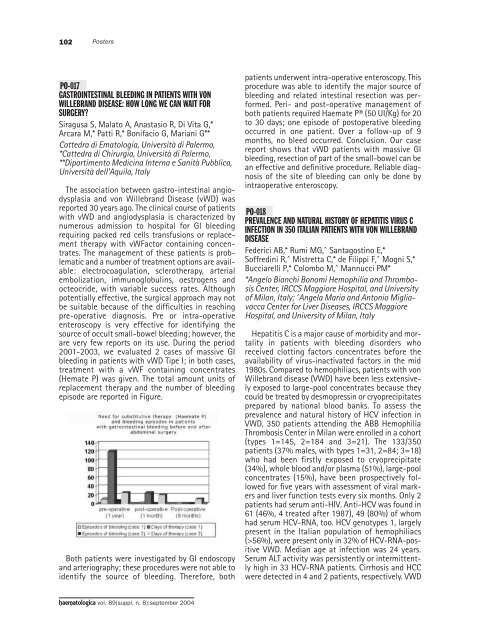Haematologica 2004;89: supplement no. 8 - Supplements ...
Haematologica 2004;89: supplement no. 8 - Supplements ...
Haematologica 2004;89: supplement no. 8 - Supplements ...
- No tags were found...
You also want an ePaper? Increase the reach of your titles
YUMPU automatically turns print PDFs into web optimized ePapers that Google loves.
102PostersPO-017GASTROINTESTINAL BLEEDING IN PATIENTS WITH VONWILLEBRAND DISEASE: HOW LONG WE CAN WAIT FORSURGERY?Siragusa S, Malato A, Anastasio R, Di Vita G,*Arcara M,* Patti R,* Bonifacio G, Mariani G**Cattedra di Ematologia, Università di Palermo,*Cattedra di Chirurgia, Università di Palermo,**Dipartimento Medicina Interna e Sanità Pubblica,Università dell'Aquila, ItalyThe association between gastro-intestinal angiodysplasiaand von Willebrand Disease (vWD) wasreported 30 years ago. The clinical course of patientswith vWD and angiodysplasia is characterized bynumerous admission to hospital for GI bleedingrequiring packed red cells transfusions or replacementtherapy with vWFactor containing concentrates.The management of these patients is problematicand a number of treatment options are available:electrocoagulation, sclerotherapy, arterialembolization, immu<strong>no</strong>globulins, oestrogens andocteocride, with variable success rates. Althoughpotentially effective, the surgical approach may <strong>no</strong>tbe suitable because of the difficulties in reachingpre-operative diag<strong>no</strong>sis. Pre or intra-operativeenteroscopy is very effective for identifying thesource of occult small-bowel bleeding; however, theare very few reports on its use. During the period2001-2003, we evaluated 2 cases of massive GIbleeding in patients with vWD Tipe I; in both cases,treatment with a vWF containing concentrates(Hemate P) was given. The total amount units ofreplacement therapy and the number of bleedingepisode are reported in Figure.Both patients were investigated by GI endoscopyand arteriography; these procedures were <strong>no</strong>t able toidentify the source of bleeding. Therefore, bothpatients underwent intra-operative enteroscopy. Thisprocedure was able to identify the major source ofbleeding and related intestinal resection was performed.Peri- and post-operative management ofboth patients required Haemate P® (50 UI/Kg) for 20to 30 days; one episode of postoperative bleedingoccurred in one patient. Over a follow-up of 9months, <strong>no</strong> bleed occurred. Conclusion. Our casereport shows that vWD patients with massive GIbleeding, resection of part of the small-bowel can bean effective and definitive procedure. Reliable diag<strong>no</strong>sisof the site of bleeding can only be done byintraoperative enteroscopy.PO-018PREVALENCE AND NATURAL HISTORY OF HEPATITIS VIRUS CINFECTION IN 350 ITALIAN PATIENTS WITH VON WILLEBRANDDISEASEFederici AB,* Rumi MG,^ Santagosti<strong>no</strong> E,*Soffredini R,^ Mistretta C,* de Filippi F,^ Mogni S,*Bucciarelli P,* Colombo M,^ Mannucci PM**Angelo Bianchi Bo<strong>no</strong>mi Hemophilia and ThrombosisCenter, IRCCS Maggiore Hospital, and Universityof Milan, Italy; ^Angela Maria and Antonio MigliavaccaCenter for Liver Diseases, IRCCS MaggioreHospital, and University of Milan, ItalyHepatitis C is a major cause of morbidity and mortalityin patients with bleeding disorders whoreceived clotting factors concentrates before theavailability of virus-inactivated factors in the mid1980s. Compared to hemophiliacs, patients with vonWillebrand disease (VWD) have been less extensivelyexposed to large-pool concentrates because theycould be treated by desmopressin or cryoprecipitatesprepared by national blood banks. To assess theprevalence and natural history of HCV infection inVWD, 350 patients attending the ABB HemophiliaThrombosis Center in Milan were enrolled in a cohort(types 1=145, 2=184 and 3=21). The 133/350patients (37% males, with types 1=31, 2=84; 3=18)who had been firstly exposed to cryoprecipitate(34%), whole blood and/or plasma (51%), large-poolconcentrates (15%), have been prospectively followedfor five years with assessment of viral markersand liver function tests every six months. Only 2patients had serum anti-HIV. Anti-HCV was found in61 (46%, 4 treated after 1987), 49 (80%) of whomhad serum HCV-RNA, too. HCV ge<strong>no</strong>types 1, largelypresent in the Italian population of hemophiliacs(>56%), were present only in 32% of HCV-RNA-positiveVWD. Median age at infection was 24 years.Serum ALT activity was persistently or intermittentlyhigh in 33 HCV-RNA patients. Cirrhosis and HCCwere detected in 4 and 2 patients, respectively. VWDhaematologica vol. <strong>89</strong>(suppl. n. 8):september <strong>2004</strong>
















